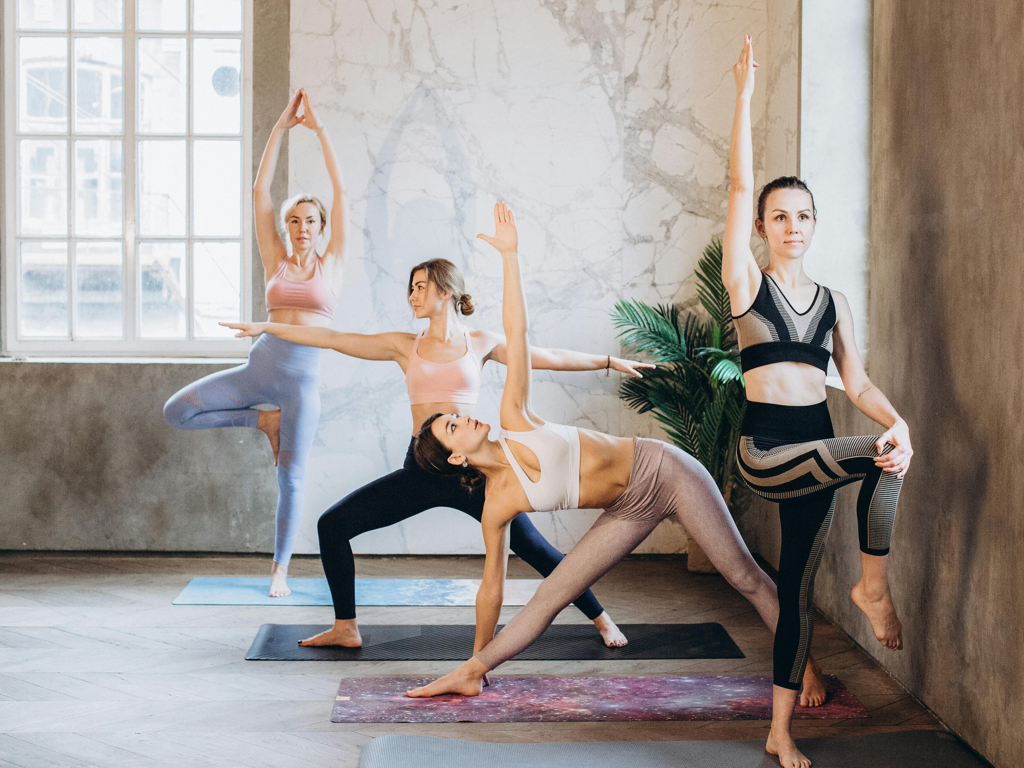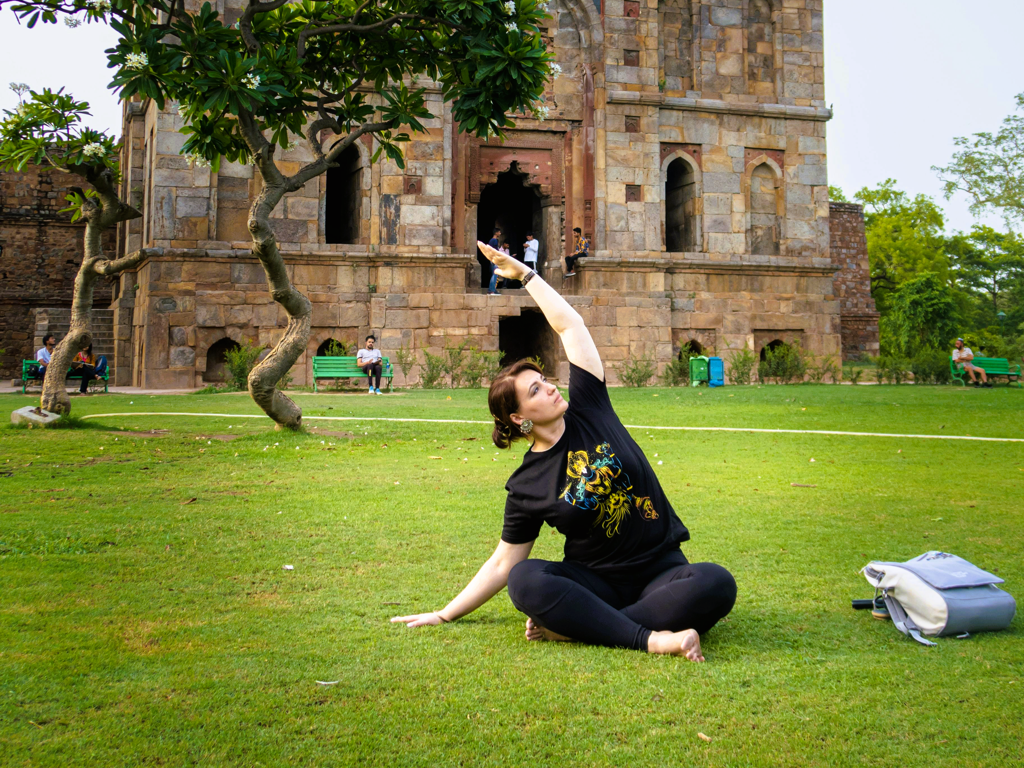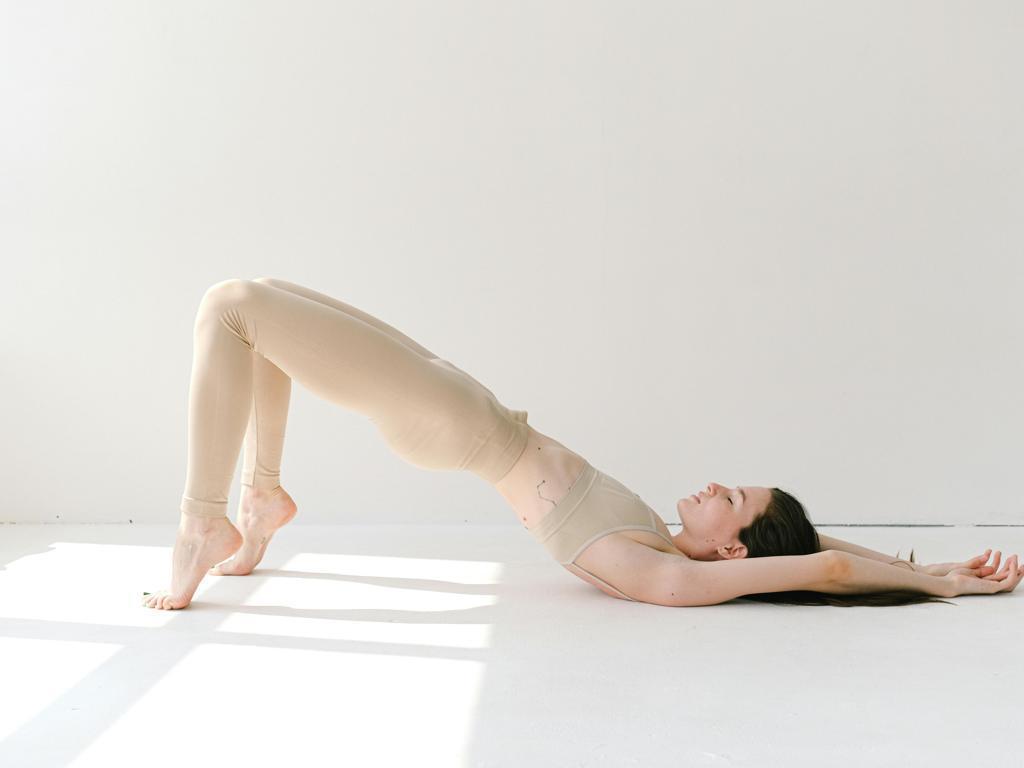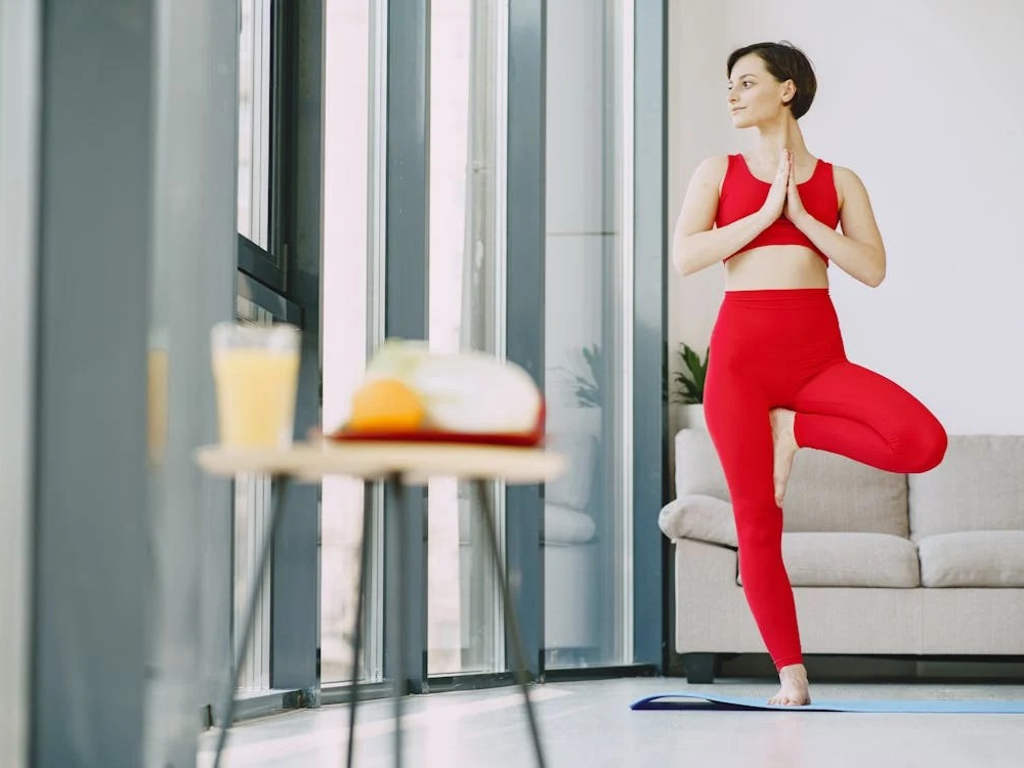On & Beyond the Yoga Mat

Cultivating Serenity: Crafting Your Sacred Sanctuary
In the wake of a tumultuous year, where plans were dashed and routines upended, countless people find themselves yearning for solace amidst life's chaos. As the world continues to navigate the challenges brought about by recent global events, the lingering effects of unprecedented times still linger in our collective consciousness. Yet, within these walls lies an opportunity for transformation—a chance to carve out our own oasis of tranquility. In the pursuit of inner peace, there exists a powerful tool: the creation of a sacred space. While there are no rigid guidelines for crafting a sacred space, there are simple steps to help you embark on this journey of self-discovery. Begin by identifying a corner of your home that resonates with you—a space free from distractions where you can retreat into serenity. Whether it's a cozy nook by the window or a tranquil corner of your garden, choose a location that speaks to your soul. For yoga enthusiasts embarking on their yoga teacher training journey, a spacious area to unfurl your mat and delve into your practice is essential. The heart of your sacred space lies in the altar—a tangible expression of your innermost desires and intentions. Let your imagination run wild as you adorn your altar with symbolic treasures. From crystals that shimmer with healing energy to fragrant incense that dances on the air, each element serves to engage your senses and elevate your practice. As you curate your sacred space, imbue it with objects that carry personal significance—a photograph that evokes cherished memories, a trinket passed down through generations, or a memento from a meaningful journey. These tokens serve as reminders of your journey and anchor you to the present moment. Incorporate ritual into your daily practice, setting aside dedicated time to commune with your inner self. Whether it's a morning meditation or an evening yoga session, consistency is key. By weaving these sacred rituals into the fabric of your life, you create space for reflection and growth. Above all, remember that the creation of a sacred space is an ongoing journey—a fluid exploration of self-discovery and transformation. Allow yourself the grace to evolve alongside your sanctuary, embracing the ebb and flow of life's currents. As you embark on this odyssey of self-discovery, let your sacred space serve as a beacon of light, guiding you on your path to self-realization. By nurturing a sanctuary within your home, you embark on a journey of profound inner transformation—a journey fueled by intention, creativity, and a deep reverence for the sacred within. With the foundation laid for your sacred sanctuary, take the first step towards profound self-discovery and spiritual growth. Allow the wisdom of your heart to guide you as you navigate the depths of your inner landscape, unlocking the boundless potential that lies within. And what better way to deepen your journey of self-discovery than by immersing yourself in a yoga retreat or embarking on a yoga teacher training program? Imagine escaping the noise of daily life and stepping into a world of serenity, where every breath brings you closer to inner harmony. Whether you're a seasoned yogi or just beginning your practice, these transformative experiences offer a sanctuary for body, mind, and spirit. Join us as we delve into the ancient wisdom of yoga, exploring the depths of asana, meditation, and pranayama in breathtaking natural settings. Our expert instructors will guide you on a journey of self-exploration, helping you unlock your full potential and cultivate a deeper connection with yourself and the world around you. Whether you're seeking a rejuvenating retreat to recharge your spirit or aspiring to become a certified yoga teacher, our programs offer something for everyone. Step onto the path of self-discovery and embark on a transformative journey unlike any other. Your sacred sanctuary awaits.

Achieve Your Wellness Dreams: 7 Steps to SMART Goals in Yoga Retreats and Teacher Training
In the pursuit of wellness, setting goals is not just a practice; it's an art. Achieving those goals, however, requires more than wishful thinking—it demands strategy, dedication, and a touch of humor to keep the journey enjoyable. That's where SMART goals come into play—Specific, Measurable, Achievable, Relevant, and Time-bound. Picture it as your roadmap to success, with a sprinkle of mindfulness and a dash of determination. Here's how to navigate your path to wellness with SMART goals, whether you're embarking on a yoga retreat, diving into yoga teacher training, or simply seeking to enhance your practice. Before diving headfirst into your wellness adventure, take a moment to envision your destination. Set a realistic goal—one that excites you yet is within your reach. Whether it's mastering a challenging pose, deepening your meditation practice, or honing your teaching skills, start with a target that aligns with your current abilities and aspirations. Remember, Rome wasn't built in a day, and neither are wellness transformations. Now that you've crystallized your goal, it's time to give it life. Grab a journal, open a note on your phone, or carve it into stone (if that's your style). Write down your goal with clarity and conviction. Want to lead a yoga class with confidence? Aim to complete a teacher training course within a specific timeframe. Dreaming of mastering inversions? Set milestones to track your progress. Be specific, be bold, and most importantly, be honest with yourself. They say sharing is caring, and when it comes to wellness goals, it's also empowering. Share your aspirations with a trusted friend, your yoga community, or even your furry companion. Vocalizing your intentions not only solidifies your commitment but also invites accountability and support from those around you. Plus, who doesn't love a cheerleading squad during challenging moments? With your goal in sight and your support system in place, it's time to craft your roadmap to success. Design a plan tailored to your lifestyle, preferences, and schedule. If you're aiming to deepen your practice, schedule regular yoga sessions supplemented with meditation and breathwork. For aspiring teachers, outline your study hours, practice teaching sessions, and self-care rituals to maintain balance amidst the journey. As you embark on your wellness journey, remember to honor your body's wisdom and embrace mindful movement. Whether you're flowing through asanas, exploring pranayama techniques, or delving into the philosophy of yoga, listen to your body's cues and adjust accordingly. Progress isn't always linear, but each breath, each stretch, brings you closer to your goal. Wellness extends beyond the mat—it permeates every aspect of your being. Fuel your body with nourishing foods, hydrate mindfully, and prioritize restorative practices to support your journey. Explore holistic approaches to nutrition, incorporating plant-based meals, wholesome snacks, and rejuvenating rituals into your daily routine. Remember, wellness is a lifestyle, not a destination. Along the path to wellness, celebrate every victory, no matter how small. Whether you master a challenging pose, complete your teacher training, or simply show up on the mat consistently, each milestone is a testament to your dedication and resilience. Treat yourself to moments of joy, gratitude, and self-reflection, honoring the progress you've made and the growth that lies ahead. In the tapestry of wellness, setting and achieving goals is a transformative journey—one that requires dedication, resilience, and a sprinkle of magic. With SMART goals as your compass and mindfulness as your guide, embark on your path to wellness with confidence, curiosity, and an open heart. Whether you're stepping onto your mat for a yoga retreat, diving into yoga teacher training, or simply embracing your practice, remember: the journey is yours to savor, every step of the way.

Transforming Your Life Through Yoga Teacher Training: A Journey of Self-Discovery
Are you considering taking your yoga practice to the next level? Yoga teacher training offers a unique opportunity to deepen your understanding of yoga, challenge yourself, and embark on a transformative journey. Here's why investing in a yoga teacher training program could be the best decision you'll make for your personal growth and well-being: Yoga teacher training programs often take place in stunning locations around the world. This gives you the chance to combine your passion for yoga with travel and cultural immersion. Whether you find yourself practicing on a tranquil beach, in a lush rainforest, or high in the mountains, the change of scenery can inspire new perspectives and foster personal growth. Let's be clear: yoga teacher training is challenging. You'll likely face physical, mental, and emotional hurdles. From early morning practices to long days of study, you'll be pushed out of your comfort zone. However, it's through these challenges that you'll discover your true strength and resilience. One of the most significant benefits of yoga teacher training is the profound impact it has on your personal practice. Daily asana sessions, meditation, and pranayama exercises will help you build strength, flexibility, and mindfulness. You'll gain a deeper understanding of alignment, sequencing, and the subtle aspects of each pose. Yoga teacher training brings together people from diverse backgrounds who share a common interest in yoga and personal development. The bonds formed during these intensive programs often turn into lasting friendships. You'll have the opportunity to learn from and be inspired by your fellow trainees. Many yoga teacher training programs encourage participants to disconnect from technology and social media. This digital detox allows you to focus on your inner journey without distractions. You'll have the chance to reconnect with yourself and nature in a meaningful way. Yoga teacher training isn't just about perfecting physical postures. You'll dive deep into yoga philosophy, studying ancient texts and exploring how these teachings apply to modern life. This knowledge will enrich your practice and provide a solid foundation for teaching others. Even if you don't plan to become a yoga instructor, the skills you'll learn during teacher training are invaluable. You'll improve your communication skills, learn how to sequence classes, and understand how to guide others safely through a practice. These skills can be applied in many areas of life, not just in a yoga studio. Yoga teacher training provides a unique environment for self-reflection and personal growth. Through intensive practice, study, and community living, you'll have the opportunity to explore your values, beliefs, and goals. Many participants report experiencing significant personal breakthroughs during their training. Most yoga teacher training programs emphasize holistic health. You'll likely enjoy nutritious meals, learn about Ayurveda, and develop habits that support overall well-being. This focus on health can lead to lasting positive changes in your lifestyle. As you progress through your training, you'll notice a boost in your confidence. Whether it's mastering a challenging pose, leading your first class, or simply speaking in front of a group, you'll develop a sense of self-assurance that extends beyond the yoga mat. Yoga teacher training programs typically include in-depth study of human anatomy and physiology. This knowledge will deepen your understanding of how the body works, allowing you to practice and teach yoga more effectively and safely. Through regular meditation and mindfulness practices, you'll learn to be more present in your daily life. This increased awareness can lead to reduced stress, improved relationships, and a greater sense of overall well-being. Many yoga teacher training programs expose students to various yoga styles. This broad exposure can help you find the style that resonates most with you and expand your practice beyond what you're familiar with. During your training, you'll learn how to structure and maintain a consistent home practice. This skill is invaluable for continuing your yoga journey long after the training ends. Completing a yoga teacher training program connects you to a worldwide community of yoga practitioners and teachers. This network can provide support, inspiration, and opportunities for continued learning and growth. Investing in a yoga teacher training program is more than just learning to teach yoga—it's a transformative experience that can positively impact every aspect of your life. From improving your physical practice to deepening your understanding of yoga philosophy, from connecting with like-minded individuals to discovering your true potential, the benefits are far-reaching and long-lasting. Whether you aspire to teach yoga professionally or simply want to deepen your personal practice, a yoga teacher training program offers a unique opportunity for growth and self-discovery. It's a chance to step away from your daily routine, immerse yourself in yoga, and emerge with new skills, knowledge, and perspectives. Remember, the journey of yoga is ongoing. A teacher training program is not the end goal, but rather a significant step on your path of lifelong learning and growth. It's an investment in yourself that can yield dividends in all areas of your life. So, are you ready to take this transformative step? Whether you choose a local training or decide to travel to an exotic location, a yoga teacher training program could be the catalyst for positive change you've been looking for. Your yoga journey is uniquely yours—embrace it, challenge yourself, and see where it leads you. The mat is rolled out, and the journey awaits. Will you take that first step?

Yoga Alchemy: Crafting Consciousness through Teaching and Learning
Have you ever dreamt of deepening your yoga practice by guiding others or seeking rejuvenation through a transformative yoga retreat? As a seasoned yoga teacher, my journey has been an incredible exploration, brimming with moments of profound growth and delightful discoveries. Through this odyssey, I've gleaned valuable wisdom that resonates deeply with aspiring yoga instructors embarking on teacher training programs and yogis seeking revitalization through yoga retreats. Let me share six key insights that have illumined my path, with the hope that they spark inspiration on yours. While guiding others on their yoga expedition is undeniably fulfilling, it's easy to lose sight of self-care's importance. Remember, nurturing your own well-being is the cornerstone of effective teaching. Schedule moments of solitude and introspection to replenish your spirit and better serve your students. Whether it's meditation, journaling, or simply communing with nature, carve out sacred spaces for self-renewal amidst life's whirlwind. Fostering a sense of community within your yoga classes is paramount for a yoga teacher. Yoga transcends physical postures; it's a journey of shared growth and interconnectedness. Encourage students to support one another, creating an environment of inclusivity and empathy. Facilitate group discussions or partner poses to nurture connections that extend beyond the yoga mat. Consider hosting yoga retreats – a perfect opportunity to cultivate a deeper sense of community amidst breathtaking landscapes or serene yoga studios. During my initial foray into yoga teacher training, I eagerly absorbed every intricate detail of the practice, fixated on achieving perfect alignment and delving into the minutiae of each asana. However, when I transitioned into the role of instructor, I quickly realized that bombarding students with complex cues only served to confuse rather than empower. Understanding your students' demographics and experience levels is crucial. Simplify your instructions to resonate with a diverse range of learners. Instead of overwhelming them with technical jargon, opt for clear, concise directives that promote accessibility and comprehension. As students develop awareness, gradually introduce nuanced cues, ensuring a smooth progression in their practice. One memorable encounter involved a determined student adamant about attempting inversions despite medical precautions. Torn between my desire to accommodate and my responsibility to prioritize safety, I acquiesced, only to witness her discomfort after class. As a yoga instructor, setting boundaries is crucial. While fostering growth is essential, it's imperative to recognize and respect students' limitations. Cultivate a balanced approach, blending firm guidance with compassionate understanding. Embrace the power of "no" to safeguard your students' well-being, fostering an environment of trust and accountability. Caught up in the demands of teaching, I inadvertently neglected my personal practice, leading to a decline in both physical and mental stamina. Struggling through classes, I realized the profound impact of this oversight. Prioritize your personal practice as diligently as you do your teaching commitments. Dedicate time on the mat to nourish your mind, body, and soul. By diligently nurturing your own practice, you not only revitalize your teaching but also embody the humility of a lifelong student. Embrace each session as an opportunity for growth, infusing your teaching with renewed vitality and authenticity. Consider attending yoga retreats – a perfect environment to reignite your passion for practice amidst stunning locations and inspiring instructors. Yoga is a dynamic practice brimming with endless possibilities for exploration and growth. Cultivate a mindset of continuous learning, remaining open to new techniques, philosophies, and perspectives. Attend workshops, delve into advanced yoga teacher training programs, and seek mentorship from experienced instructors. By nurturing a spirit of curiosity and receptivity, you'll enrich your teaching repertoire and inspire your students to embark on their own transformative journeys. The yoga teacher's path is one of profound self-awareness and ongoing evolution. By embracing simplicity, setting boundaries with compassion, nurturing your personal practice, cultivating a supportive community, prioritizing self-care, and embracing lifelong learning, you'll navigate this transformative journey with grace and authenticity. May these insights serve as guiding lights as you embark on your enriching adventure, whether it's an inspiring yoga teacher training program or a transformative yoga retreat.

A New Year, A Renewed Yoga Journey
As we approach a new year, the urge to set intentions and prioritize well-being naturally arises. For many yoga enthusiasts, establishing a consistent practice is a cherished goal. Whether you're a seasoned yogi or a curious newcomer, this year could be the beginning of your lifelong yoga adventure. The foundation of a successful yoga practice often starts with finding the right teacher. Imagine them as your personal yoga compass, guiding you towards deeper understanding and proper alignment. A compatible instructor goes beyond just correcting poses; they offer invaluable support and encouragement. They become mentors, offering fresh perspectives when motivation dips and creative solutions when progress plateaus. Consistency is key here – sticking with one teacher allows them to witness your growth, tailoring their guidance to your unique journey. Making yoga an integral part of your daily routine requires dedication. Treat your practice with the same respect you would any other crucial appointment. Schedule it in your planner, carve out dedicated time in your day, and stick to it as religiously as possible. Early mornings are a perfect time to begin your practice. Not only does it set a positive tone for the day, but it also helps loosen up sleep-stiffened muscles and prepares you for the day ahead. While a consistent home practice is essential, consider incorporating a yoga retreat into your journey. Imagine yourself immersed in a serene environment, surrounded by nature and fellow yoga enthusiasts. Yoga retreats offer intensive practice sessions led by experienced instructors, allowing you to refine your technique and explore new aspects of yoga. Often nestled in breathtaking locations, these retreats provide a holistic experience, combining yoga with meditation, healthy meals, and opportunities to reconnect with yourself. Have you ever considered sharing your passion for yoga and inspiring others? Yoga teacher training programs equip you with the knowledge and skills to become a certified yoga instructor. These immersive programs delve into the philosophy, anatomy, and methodology of yoga, transforming you from a student to a teacher. Imagine the joy of guiding others on their own yoga journeys, fostering a sense of community, and witnessing their transformations. Yoga goes beyond mere physical postures (asanas); it's a holistic philosophy that encompasses your entire being. If your practice is currently limited to asanas, consider venturing beyond the mat. Explore the rich tapestry of yoga by delving into meditation and incorporating mindful living practices. Meditation is a powerful tool for cultivating inner peace and focus. Start by dedicating a few minutes after each yoga session to quieting your mind and focusing on your breath. As you progress, explore guided meditations or mindfulness techniques to further enhance your practice. Integrating yoga into your everyday life fosters a deeper connection with the practice. Consider adopting mindful living practices that resonate with you, such as a plant-based diet. Ahimsa (non-violence), one of yoga's core principles, extends to compassion for all living beings. Explore vegetarian or vegan options, not only for your health but also to align your actions with your yoga philosophy. By embracing these practices, you'll cultivate a yoga journey that extends far beyond the confines of your yoga mat. It will transform into a way of life, enriching your physical, mental, and spiritual well-being. So, as you embark on a new year, consider making a commitment to yourself and your yoga practice – a commitment that transcends a single year and blossoms into a lifelong adventure of self-discovery and growth.
Craving More Stories?
Join our ShopYogaRetreats newsletter for the latest updates on thrilling
destinations and inspirational tales, delivered straight to your inbox!
We value your privacy. Your email address will never be shared or published.

Court-Ready: Transform Your Tennis Game with These Yoga Poses
Looking to dominate the court with peak performance and grace? Look no further than yoga! Tennis, with its explosive movements and strategic demands, requires a well-rounded approach to training. Yoga swoops in as the perfect partner, enhancing your flexibility, strength, and mental focus – all while reducing your risk of injury. Whether you're a seasoned competitor or a weekend warrior, incorporating yoga into your routine can be a game-changer. Let's delve into seven key yoga poses aimed at having you serving aces and chasing down lobs with newfound confidence! This foundational pose stretches your entire body, lengthening the spine, hamstrings, and strengthening the arms and shoulders. For tennis players, Downward-Facing Dog is a godsend, improving flexibility and reducing injury risk by targeting those key muscle groups used for powerful strokes. Pro Tip: Maintain shoulder-width hand placement and hip-width feet. Press your heels down actively to deepen the stretch in your hamstrings and calves. The Triangle Pose is your go-to for stretching your legs and opening up your hips, chest, and shoulders. This pose refines your balance and stability, crucial for those quick changes of direction that leave opponents scrambling. It also enhances overall flexibility and body awareness, making you feel light and agile on the court. Pro Tip: Keep your chest open and shoulders relaxed. Engage your core muscles for a strong, supported spine, and avoid overextending. Tennis requires strong legs and unwavering stamina. Chair Pose is your secret weapon for building leg strength, particularly targeting your thighs and quads. Additionally, it strengthens the muscles supporting your hips, knees, and ankles, keeping you injury-free and ready to conquer the court. Pro Tip: Keep your tailbone tucked under to avoid arching your lower back, potentially causing discomfort. Firm up your abdominal muscles for a strong core, further enhancing your stability. Channel your inner warrior with this pose! Warrior II is another excellent choice for building leg strength and endurance. Holding this pose improves the flexibility of your leg and pelvis joints, essential for those explosive movements on the court. It also opens your chest, increasing your breathing capacity, so you can dominate those long matches without breaking a sweat. Pro Tip: Ensure your bent knee is stacked directly above your ankle to avoid unnecessary tension on your joints. Proper alignment protects your body and maximizes the benefits of the pose. For dedicated players seeking to elevate their yoga practice, consider embarking on a yoga retreat or enrolling in a yoga teacher training program. These immersive experiences provide a structured environment to refine your skills, explore new techniques, and connect with a supportive community of like-minded individuals. Whether you aim to refine your flexibility, build unshakeable strength, or achieve laser-like mental focus, yoga retreats and teacher training programs offer a treasure trove of insights and tools to propel your tennis game to new heights. By integrating yoga into your tennis training, you'll achieve a harmonious balance between physical prowess and mental clarity. Embrace the holistic benefits of yoga and witness your performance on the court take flight! Whether you choose a transformative yoga retreat or embark on a comprehensive yoga teacher training journey, remember, the path to self-improvement begins with a single pose. Yoga is more than just physical exercise; it's a holistic approach to wellness that can profoundly impact your life, both on and off the court. Start incorporating these yoga poses into your routine today, and experience the transformative effects that will empower you to become the best tennis player you can be.

Nama-play! Cultivate Calm & Creativity with Kids Yoga
Yoga isn't just for downward-facing adults anymore! This ancient practice offers a treasure trove of benefits for people of all ages, including our energetic little ones. Introducing yoga to your kids can be a transformative experience, fostering a love for movement, mindfulness, and inner peace. Here are some creative and effective tips to get your child on the yoga mat, sprinkled with "yoga teacher training" and "yoga retreats" to enhance your understanding and open doors to further exploration. Instead of forcing a rigid routine, pique their interest organically. Incorporate yoga into your daily routine, letting your children see you practice. Let them see the joy you find in poses like Mountain (Tadasana), Cat-Cow (Marjaryasana-Bitilasana), and Tree (Vrksasana). Remember, children are natural mimics. Seeing your dedication might just inspire them to playfully copy your movements. Tailor your approach to their age and interests. Younger children often find animal poses utterly delightful. Imagine their faces light up as they roar like lions in Lion Pose (Simhasana) or slither like snakes in Cobra Pose (Bhujangasana). As they grow older, incorporate elements they enjoy, like songs or yoga chants. Chanting simple mantras can introduce them to the power of sound and focus. Remember, kids are boundless balls of energy, not miniature adults. Spark your child's imagination and weave stories around the poses to create an interactive yoga experience. Create imaginative games around your sequences, keeping sessions short and engaging. Let their creativity blossom! If they come up with their own unique variations of poses, celebrate their individuality. This playful approach not only makes yoga enjoyable but also injects a fresh perspective into your own practice. Teaching children to breathe consciously is a cornerstone of yoga. Simple breathing exercises can have profound benefits, equipping them with tools to empower them to find calm amidst everyday pressures.. A great technique to start with is the Bhramari, or bumblebee breath, which has a calming effect on the mind. Have your child sit comfortably, breathe in through their nose, then gently cup their ears with their palms and hum as they exhale. It's a fun and effective exercise they can easily learn and practice throughout the day. For older children, incorporating regular yoga into their lives can be incredibly beneficial. If you find it challenging to maintain consistency, consider enrolling them in a local kids' yoga class. These classes provide a structured and social environment where they can practice with their peers. Family yoga retreats offer a fantastic opportunity to immerse yourselves in yoga together. Imagine practicing under the guidance of experienced teachers in a serene setting. Family retreats can significantly enhance your family's yoga journey, fostering connection and creating lasting memories. Teaching yoga to children requires specific techniques that differ from adult instruction. To ensure a successful yoga practice for your kids, consider exploring resources online that offer valuable tips and materials to make yoga a joyful experience for children.. If you're passionate about integrating yoga into your children's lives, consider enrolling in a kids yoga teacher training course. These comprehensive programs equip you with the skills needed to create a fulfilling yoga practice for your children. Whether you choose a local program or embark on a transformative journey at a yoga retreat, teacher training empowers you to guide your kids on their yoga path. Introducing yoga to your child can be a beautiful journey of discovery. By making yoga accessible and fun, you'll nurture their physical well-being while fostering their mental and emotional growth. Whether through regular practice at home, classes, or family yoga retreats, the benefits of yoga can be a gift that lasts a lifetime. Remember, your passion for yoga can inspire not just your children, but others around you, igniting a lifelong love for this transformative practice. Perhaps, one day, you'll be practicing alongside your child who has blossomed into a confident yogi, thanks to the seeds you sowed today.

Flow and Find Your Center: Unveiling the Magic of Flow Yoga
Are you a yoga enthusiast seeking a practice that seamlessly blends movement and mindfulness? Look no further than Flow Yoga! This dynamic style offers a unique journey towards physical and mental harmony, perfect for practitioners of all levels. Many yoga practitioners, like myself, begin with classical Hatha Yoga. While it provides a solid foundation, I yearned for a more engaging practice that challenged both my body and mind. My overly analytical nature found it difficult to quiet my thoughts during static poses. Then, I discovered Flow Yoga, a revelation that felt more like dancing than a structured routine. The synchronized movement and breath became a powerful tool, anchoring me in the present moment. This dynamic meditation, where you become one with the flow of your breath and body, is what truly ignited my passion for yoga. As a former dancer, I craved a practice that was both invigorating and therapeutic. Vinyasa Flow Yoga, a form of Flow Yoga, perfectly fit the bill. It combined the joy of fluid movements with a focus on building strength and flexibility. For years, I struggled with lower back pain, seeking various solutions to maintain spinal health. Flow Yoga, however, offered a gentler yet effective path. The continuous sequences became my go-to routine, offering a fun and effective way to stay in shape. As I delved deeper into Flow Yoga, I discovered a surprising connection between my physical practice and emotional well-being. During challenging postures, tears would sometimes well up, signifying a profound emotional release. These moments of vulnerability allowed me to confront and process pent-up emotions held within my body. The rhythmic flow of breath and movement facilitated this release, gradually bringing emotional clarity and healing. This journey of self-discovery is ongoing, a testament to the transformative power of yoga. Yoga offers a comprehensive approach to calming and strengthening the mind. Instructors guide us to cultivate a positive inner dialogue and appreciate the beauty in everyday life. Flow Yoga, with its focused movements and breathwork, creates a sanctuary from negativity. It becomes a space where overthinking and anxiety fade away, replaced by a sense of calm and serenity. Each inhale and exhale becomes an opportunity to choose relaxation over stress, empowering us to navigate life with greater ease. Flow Yoga is an ideal practice for those who seek a dynamic and deeply rewarding experience. The structured sequences promote spinal health through a combination of gentle forward and backward bends. I vividly recall a suggestion that unfolded into a transformative journey, leading me to Flow Yoga. While I appreciate all forms of yoga, Flow Yoga remains my anchor, keeping me centered and connected. It's a constant reminder that life is cyclical, and sometimes all we need to do is breathe and move forward with grace. For those yearning to immerse themselves further in the world of yoga, yoga retreats and yoga teacher training programs offer exceptional experiences. Yoga retreats provide a serene escape where you can focus on personal growth, while yoga teacher training equips you with the skills to guide others on their yoga journeys. Both options offer pathways to a deeper understanding of yoga's profound benefits, enhancing both your physical and mental well-being. By incorporating Flow Yoga into your life, you can unlock a treasure trove of benefits, from improved physical fitness to emotional balance and mental clarity. Whether you're a seasoned yogi or a curious beginner, Flow Yoga offers a dynamic and fulfilling practice that fosters a deep connection between your body and mind. Embrace the flow, and let yoga be your guide to a healthier, happier you. Whether you choose a restorative yoga retreat or embark on a yoga teacher training journey, the path ahead promises to be transformative. Explore the transformative power of Flow Yoga and discover how it can enhance your physical and mental well-being. Learn more about yoga retreats and yoga teacher training to deepen your practice.

Beyond the Reflection: Unlocking Inner Awareness Through Mirror-Free Yoga
Yoga is a transformative practice that transcends physical postures. It's a journey of self-discovery that unfolds on the mat and extends far beyond the studio walls. When I first embarked on this journey, I, like many others, found myself drawn to studios filled with mirrors. Coming from a gymnastics background, mirrors were essential for perfecting form. But as I delved deeper into yoga, I realized that these reflective surfaces were creating a barrier to a more profound practice. Close your eyes and imagine the feeling of stepping onto a yoga mat at a peaceful retreat. Lush greenery surrounds you, and the calming sounds of nature wash over you. Or picture yourself immersed in a yoga teacher training program, honing your skills and deepening your understanding in a supportive and inspiring environment. In both scenarios, the absence of mirrors cultivates a deeper sense of self-awareness and a more fulfilling yoga practice. While the initial transition to a mirror-free practice might feel unsettling, the benefits are undeniable. Here are five reasons why ditching the mirrors can unlock a whole new level of experience in your yoga journey, whether you're participating in a retreat or undergoing teacher training: Mirrors can be breeding grounds for self-criticism and comparisons. They heighten our awareness of physical imperfections, leading to comparisons and negativity. In a mirror-free environment, the focus shifts inward. This cultivates a deeper connection with your body, fostering a more mindful and compassionate practice. You'll be less distracted by external validation and more attuned to your own unique journey. Yoga is for everyone, regardless of experience or ability. However, seeing others effortlessly contort themselves into complex poses can be intimidating, especially for newcomers. Without mirrors, the emphasis shifts away from achieving picture-perfect poses and towards self-exploration. This creates a more inclusive environment where everyone feels welcome to practice at their own pace, free from the pressure to compete. We all have poses that challenge us. For me, it was headstands. Seeing others effortlessly balance upside down while I wobbled and struggled only fueled my frustration. But in a mirror-free space, I found myself embracing a more positive self-image. My focus shifted to strengthening the foundational elements of the pose and trusting the process. This shift in perspective not only helped me master the headstand but also instilled a valuable lesson in acceptance and self-compassion. Without relying on visual cues, we're forced to tap into our internal sense of alignment. This can be challenging at first, but it ultimately leads to a deeper connection with our bodies. We learn to feel the subtle shifts and sensations as we move through poses, rather than relying solely on sight. This heightened awareness allows us to integrate breath, movement, and focus more seamlessly, fostering a truly holistic practice. Mirrors can be a significant distraction, dividing our focus between our reflection and the present moment with the teacher. In a mirror-free environment, our focus naturally returns inward. We become more attentive to the teacher's instructions, allowing us to absorb the nuances of each pose and practice with greater depth. This heightened focus also helps quiet the mind and cultivate inner stillness, which is an essential aspect of yoga. By eliminating the external distractions of mirrors, we create space for introspection and self-discovery. Whether you're seeking a transformative yoga retreat or considering a path towards becoming a yoga teacher, embracing a mirror-free practice can significantly enhance your experience. It paves the way for self-acceptance, a deeper connection with your inner self, and a more fulfilling yoga journey overall. So, the next time you step onto your mat, believe that the power to transform is already within you. Let go of external validation, embrace the journey of self-discovery, and unlock the transformative potential of a mirror-free practice.

Creating Harmony: Unspoken Rules for Your Yoga Practice
Yoga's transformative power has drawn a diverse community seeking physical and mental well-being. New faces joining classes are a welcome sight, eager to explore the practice's depths. However, with this influx comes a variety of experiences that can disrupt the peaceful flow of a yoga class. While yoga embraces all, a few key principles can cultivate a serene and focused environment for everyone. Here's how you can elevate your practice, especially in group settings. Imagine yourself gracefully flowing through a challenging Warrior pose, only to be yanked back to reality by a blaring phone. Yoga thrives on focus and serenity. Disruptions like ringing phones not only break your concentration but also disturb the entire class. To cultivate a tranquil space, silence or turn off your phone. Consider this a digital detox, allowing you to be fully present and reap the benefits of the practice. If you're anticipating an urgent call, set an automatic response and check messages after class. Catching up with fellow yogis before class fosters a sense of community. However, remember that yoga is a deeply personal journey. Chatting during the session can be distracting, both for you and others. Yoga classes are a sanctuary of silence where individuals can focus on their breath and movements. Questions are always welcome, but approach the instructor quietly or save them for after class when there's time for open discussion. This respect for silence allows everyone to achieve a deeper state of mindfulness. Personal hygiene is paramount in a shared practice space. Sweating is natural during yoga, but being mindful is key. Bringing a yoga towel ensures you don't unintentionally leave puddles for others, maintaining a clean and comfortable environment for all. This versatile prop can even enhance your practice by providing extra grip or doubling as a strap for poses. Yoga is about self-discovery and gradual improvement. Pushing past your limits can lead to injuries, hindering the practice's benefits. Be your own best guide and respect your body's boundaries. Whether you're on a yoga retreat or considering yoga teacher training, remember that mastering advanced poses takes time and dedication. The core of yoga lies in consistent, mindful practice, not achieving picture-perfect poses. Savasana, or Corpse Pose, is often seen as a cool-down, but it's a crucial part of any yoga session. In this pose, lying down on your back, you integrate the physical and mental benefits of your practice. Skipping Savasana means missing out on essential relaxation and rejuvenation. This final rest helps soothe the nervous system, calm the mind, and leave you feeling refreshed and centered. Respecting these etiquettes not only enhances your own practice but also fosters a harmonious and respectful community. Whether you're a seasoned yogi or a newbie, adhering to these guidelines ensures everyone can fully benefit from yoga. Considering a yoga retreat or yoga teacher training? These experiences offer an immersive journey into the core principles of yoga, including etiquette. They provide a unique opportunity to deepen your practice, learn from experienced instructors, and connect with a supportive community of like-minded individuals. By embracing these simple yet impactful etiquettes, you can transform your yoga experience and contribute to a focused environment where everyone thrives. Now go forth and practice with a smile!
Dreaming of a Yoga Retreat?
We have the best deals and offers from thousands of organizers all over the world! Get them into your mailbox every week!
We value your privacy. Your email address will never be shared or published.

 English
English Deutsch
Deutsch Français
Français Nederlands
Nederlands Español
Español









